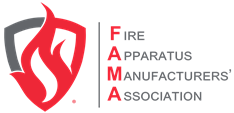Introduction
The National Fire Protection Association (NFPA) has for years published standards for fire apparatus. Beginning with apparatus contracted for after January 1, 2024, these standards have been renamed and renumbered. The standards have also been revised. This document presents the highlights of these changes and is for reference only. Refer to the actual standards documents available at NFPA.org.
Contents
NFPA Standards Document Reorganization
The NFPA has been reorganizing many of its standards and combining them in various ways. Fire apparatus are now covered by two main standards:
- NFPA 1900 Standard for Aircraft Rescue and Firefighting Vehicles, Automotive Fire Apparatus, Wildland Fire Apparatus, and Automotive Ambulances.
NFPA 1900 replaces NFPA 414, NFPA 1901, NFPA 1906, and NFPA 1917
- NFPA 1910 Standard for the Inspection, Maintenance, Refurbishment, Testing and Retirement of In-Service Emergency Vehicles and Marine Firefighting Vessels.
NFPA 1910 replaces NFPA 1911, NFPA 1912, NFPA 1925, and NFPA 1071
Formatting Changes
The new standards have completely new chapter numbers and are much longer, since they each combine all the content that was previously in four documents. Chapter numbers have been changed, and some chapters consolidated. Many of the chapters that were unique between NFPA 1901 and 1906 were combined.
Content Change Highlights for NFPA 1901 and 1906
OPERATOR MANUAL AVAILABILITY
Manuals must be available in one of three ways:
- Hardcopy on the apparatus
- Electronic display
- Link (QR Code) to the website download
- All the information that UL would need to perform the annual and five year NFPA 1910 aerial test must be located in the operator manual
WATER FORDING
Manufacturers will be required to state the height of the lowest portion of the air intake system that is not sealed (open to water intrusion) in the operator manual.
ELECTRIC VEHICLE ACCOMMODATION
The old standards were written before the advent of electric vehicles and included requirements that were not appropriate for EVs. Chapters were rewritten in a way that makes a distinction between electric propulsion and internal combustion engine propulsion. Certain unique EV safety requirements were added as well. Requirements for batteries now make a distinction between high voltage and low voltage batteries.
REQUIREMENTS BY APPARATUS TYPE
The old standards had unique chapters for the requirements of unique apparatus types such as pumper, initial attack, mobile water supply, etc. These requirements were combined into a single chapter with a master table that indicates requirements by type. Most the of loose equipment requirements including ground ladders, hose, and nozzles are no longer required, but instead have been moved to the annex as suggestions only.
STRUCTURAL AND WILDLAND CHAPTERS COMBINED
In past revisions the apparatus committee made an effort to have 1901 (structural) and 1906 (wildland) chapters match one another wherever possible. When these chapters were combined into a single document it was clear that there was a significant amount of duplication of text. These chapters were therefore combined. For those features where there is a difference the text will call for the feature to apply only to “Structural” or “Wildland” apparatus as appropriate.
NIGHT MODE FOR WARNING LIGHTS
The committee debated extensively the need for a mode that would reduce the intensity of warning lights for nighttime operation. It became clear that the high intensity of most current warning lights is not required by the standard at all but is a result of competitive pressures within the lighting industry. The minimum intensity standards are already appropriate for nighttime operation. Guidelines for warning light night mode features have been added to the annex.
BACKUP CAMERA
A rear view camera is now required on all apparatus.
LOW VOLTAGE BATTERY CHARGERS
Battery chargers that are permanently installed on the apparatus will need to be tested prior to delivery. The test requirements were pulled directly from the annual test required by NFPA 1911.
SEATING
The new standard is more specific about providing adequate room for occupants. A distinction is made between a seat that is intended to be occupied on every response, and those seats that are provided for occasional use. The purchaser must be intentional about seating configurations and consider more carefully how they plan to staff the cab.
CLEAN CAB
Clean cab features are not required in the new standard, but guidance is provided in the annex for those wishing to adopt clean cab procedures.
EQUIPMENT AND LADDER RACKS
The equipment rack section was revised to provide requirements for both automatic and manual racks with an eye to ergonomics of deployment.
REAR CHEVRON STRIPING
The requirement for rear chevron striping is retained, but the color requirement is now optional.
HOSE REEL REWIND
Any hose reel with more than 100 feet of hose must include a powered rewind function.
AERIAL STABILIZER PAD SIZE
The maximum aerial stabilizer pad pressure allowed has been increased from 75 psi to 100 psi. This may reduce the size of the stabilizer pads depending on the weight of the apparatus.
AERIAL LOAD CHART DEFINED
Every aerial device has a load chart but the requirements for the load chart have never been defined. The new standard requires the following minimum information:
- Rated capacity through the range of motion of the device
- Rated vertical height
- Rated horizontal reach
- Rated water flow (if applicable)
- Rated wind speed
Apparatus Safety through the Years
The table provides a snapshot of common safety features and NFPA requirements going back in time. Determine the age of your in-service apparatus and use the table to see the features or NFPA requirements that have been added since your apparatus was built. This will help you determine whether a new purchase or refurbishment should be considered.
For the table, please see to the downloadable pdf.

